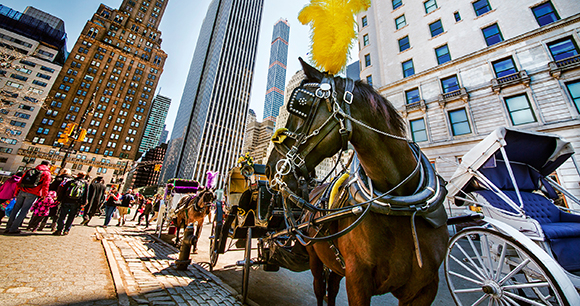
In many cities, horse-drawn carriages are seen as tourist attractions, evoking nostalgic images of days gone by. Yet, underlying these quaint notions is the reality for the horses: daily exposure to noise and pollution, heavy traffic, hard pavement, long workdays, constant heavy loads, and lack of access to pasture. All of these aspects are directly detrimental to horses’ welfare.
The Issues
Sourcing
Training a horse to pull a 1,000-pound carriage is a difficult and time-consuming process, with no guarantee that the horse will be up to the task. Since carriage drivers do not have the time, facilities, or funds to do this themselves, they purchase horses who are already accustomed to pulling a carriage. Such horses most often come from farms, where they have already put in many years of labor and are being sold because they are no longer capable of working on the farm. Once they become urban carriage horses, their lifespans are greatly reduced. Records and data from the New York Department of Health show a high annual turnover rate.1 Horses not re-registered are often sold at auction, either to return to farm work or be sold for slaughter, with only rare opportunities for true retirement.
Hooves
Proper care of a horse’s hooves is critical to horses’ overall health. Long hours pounding on hard roadway surfaces can damage hooves, even when they are properly shod, causing pain with every step. The American Veterinary Medical Association recommends that horses be periodically maintained on soft surfaces (i.e., pasture), to avoid damage and facilitate circulation within the hoof.2 In most urban settings, horses have no regular access to pasture for the majority of the year. Carriage horses in New York City only spend a single five-week period every year away from pavement, not enough to adequately maintain hoof health. Many of the carriage horses will spend this period pulling wagons for fairs and events—not an ideal “vacation.”
Pollution
Carriage horses, particularly in heavily congested urban settings, spend much of their day breathing exhaust fumes from cars directly in front of them. Horses also spend hours walking through a miasma of oil, road salt, and other roadway pollutants. The health issues associated with chronic exposure to airborne and ground pollution—well-documented in people—affect horses as well. Even when horses are not pulling carriages, they are kept in inadequately ventilated stalls where they are exposed to high levels of dust contaminated with mold and other fungi. Long-term exposures to these elements lead to many respiratory conditions, including bronchitis, rhinitis, inflammatory airway disease, and reactive airway disease.
Noise
In urban settings, carriage horses are exposed to near constant, high levels of noise—up to 100 times louder than a typical conversation (often 80–100 dB).3 Chronic exposure to street noise—linked to hearing loss, poor cardiovascular health, and stress in people—most likely affects horses similarly. Further, sudden noises may frighten the horses, causing them to bolt, resulting in harm to themselves, the carriage passengers, or other vehicles or bystanders. Every year in New York City, there are multiple accidents involving carriage horses that have been startled by sudden noises.
Weather
Carriage horses are exposed to a wide range of temperatures and humidity levels. Until 2019, carriages horses in New York City worked in temperatures ranging from 18 to 90 degrees Fahrenheit. New regulations approved by the City Council in November 2019 offer mild improvement by taking factors such as the heat index into account, but carriage horses continue to operate in frigid and hot weather. Road conditions at the edges of the temperature range can be a serious issue. In hot weather, asphalt temperatures may be 50–100° F higher than the air temperature and can damage the sensitive areas of the hoof. The extreme heat also puts the horses at risk of dehydration and overheating. A typical horse will drink 5–10 gallons of water a day. Horses pulling carriages in high heat require much greater volumes (15–20 gallons), as they may lose over 10 gallons of water from evaporation. This much water is difficult to provide in an urban setting, even when water troughs are available. During high humidity days, the horses may be unable to properly cool themselves through sweating or other measures, putting them at further risk of overheating.
While the dangers of dehydration and overheating are reduced in cold weather, there are still problems. For example, salt-treated roadways are the same temperature as the air and can cause frostbite to the hoof.
The Solution
Urban carriage horses are purely a tourist attraction—not a necessity. Given the many documented health and welfare issues for the horses, the only sensible solution is to ban them from use. In April 2020, the Chicago City Council overwhelmingly voted in favor of banning horse-drawn carriages, beginning in 2021. Legislation continues to be introduced in New York City to end horse-drawn carriages. Past measures considered by the New York City Council would provide job training for the approximately 250 carriage drivers who would be affected by the ban and would also require proof that the carriage horses would not be killed after they are retired.
AWI Position Statement
AWI supports a ban on horse-drawn carriages used as tourist attractions in urban settings. The constant exposure to traffic, noise, and pollution; the long hours of standing and walking on hard surfaces; the hard labor under sometimes extreme weather conditions; and lack of pasture access are not consistent with the owner’s responsibility to provide high-quality, long-term care for the horses.
1. Source: nationalgeographic.com/animals/2020/03/new-york-city-carriage-horse-industry-controversy/#close
2. AVMA Urban Horse Fact Sheet, 2014; see avma.org/sites/default/files/resources/WEL_UrbanHorsesFactsheet_061014.pdf
3. Source: nymag.com/nymetro/urban/features/noise/9456/